Two Approaches to Analyze Whether Citizens’ National Identity Is Affected by Country, Age, and Political Orientation—A Fuzzy Eco-Apostle Model
Abstract
1. Introduction
2. National Identity as a Construct
3. Data
4. Ethnic/Civic Dichotomy
4.1. Exploratory Factor Analysis
4.2. Multigroup Confirmatory Factor Analysis
5. The Extended Eco-Apostle Model Applied to National Identity
5.1. Fuzzy TOPSIS and Fuzzy Clustering
5.2. Fuzzy-Cluster Profiles
5.3. Beyond the Classical Duality
6. Two Approaches to Analyze the Effects of Country, Age, and Political Orientation on Citizens’ National Identity
6.1. Contingency Tables
6.2. Conditional Probability Ratios
7. Discussion
7.1. National Identity Apostle Model
7.2. Effects of Country, Political Orientation, and Age in Both Waves on the National Identity Categories
8. Conclusions
Author Contributions
Funding
Institutional Review Board Statement
Informed Consent Statement
Data Availability Statement
Conflicts of Interest
References
- Yael, T. Why Nationalism; Princeton University Press: Princeton, NJ, USA, 2020. [Google Scholar]
- Smith, A.D.; Hutchinson, J.; Smith, A.D. Nationalism; Oxford Readers: Oxford, UK, 1994. [Google Scholar]
- Bonikowski, B.; DiMaggio, P. Varieties of American Popular Nationalism. Am. Sociol. Rev. 2016, 81, 949–980. [Google Scholar] [CrossRef]
- Kunovich, R.M. The sources and consequences of national identification. Am. Sociol. Rev. 2009, 74, 573–593. [Google Scholar] [CrossRef]
- Theiss-Morse, E. Who Counts as an American? The Boundaries of National Identity; Cambridge University Press: Cambridge, UK, 2009. [Google Scholar]
- Wright, M.; Citrin, J.; Wand, J. Alternative Measures of American National Identity: Implications for the Civic-Ethnic Distinction. Politi-Psychol. 2012, 33, 469–482. [Google Scholar] [CrossRef]
- Custodi, J. Nationalism and populism on the left: The case of Podemos. Nations Natl. 2021, 27, 705–720. [Google Scholar] [CrossRef]
- Sarrasin, O.; Green, E.G.T.; Davidov, E. Measurement Equivalence Across Subnational Groups: An Analysis of the Conception of Nationhood in Switzerland. Int. J. Public Opin. Res. 2013, 25, 522–534. [Google Scholar] [CrossRef][Green Version]
- Larsen, C.A. Revitalizing the ‘civic’ and ‘ethnic’ distinction. Perceptions of nationhood across two dimensions, 44 countries and two decades. Nations Natl. 2017, 23, 970–993. [Google Scholar] [CrossRef]
- Medrano, J.D. Nation, Citizenship and Immigration in Contemporary Spain. Int. J. Multicult. Soc. 2005, 7, 133–156. [Google Scholar]
- Reeskens, T.; Hooghe, M.; Meuleman, B. Beyond the civic-ethnic dichotomy: The nature of citizenship concepts in 24 countries. Nations Natl. 2007, 16, 579–597. [Google Scholar] [CrossRef]
- Conover, P.J.; Feldman, S. Memo to NES Board of Overseers Regarding ‘Measuring Patriotism and Nationalism; Interuniversity Consortium for Political and Social Research: Ann Arbor, MI, USA, 1987. [Google Scholar]
- Anderson, B. Imagined Communities: Reflections on the Origin and Spread of Nationalism; Verso Books: New York, NY, USA, 2006. [Google Scholar]
- Greenfeld, L.; Eastwood, J. National Identity. In The Oxford Handbook of Comparative Politics; Oxford University Press: Oxford, UK, 2007; pp. 256–273. [Google Scholar]
- Miller, D. On Nationality; Clarendon Press: Oxford, UK, 1995. [Google Scholar]
- Huddy, L.; Khatib, N. Patriotism, National Identity, and Political Involvement. Polit. Sci. 2011, 51, 63–77. [Google Scholar] [CrossRef]
- Huddy, L. From social to political identity: A critical examination of social identity theory. Polit. Psychol. 2001, 22, 127–156. [Google Scholar] [CrossRef]
- Jaspal, R.; da Silva Lopes, B.C.; Breakwell, G.M. British national identity and life satisfaction in ethnic minorities in the United Kingdom. Natl. Identities 2021, 23, 455–472. [Google Scholar] [CrossRef]
- Asari, E.M.; Halikiopoulou, D.; Mock, S. British national identity and the dilemmas of multiculturalism. Natl. Ethn. Polit. 2008, 14, 1–28. [Google Scholar] [CrossRef][Green Version]
- Azada-Palacios, R.A. Hybridity and national identity in post-colonial schools. Educ. Philos. Theory 2021, 1–13. [Google Scholar] [CrossRef]
- Wagner, U.; Becker, J.C.; Christ, O.; Pettigrew, T.F.; Schmidt, P. A Longitudinal test of the relation between German nationalism, patriotism, and outgroup derogation. Eur. Sociol. Rev. 2012, 28, 319–332. [Google Scholar] [CrossRef]
- Jones, F.L.; Smith, P. Individual and societal bases of national identity: A comparative multi-level analysis. Eur. Sociol. Rev. 2001, 17, 103–118. [Google Scholar] [CrossRef]
- Kohn, H. The Idea of Nationalism: A Study in Its Origins and Background; Transaction Publishers: Piscataway, NJ, USA, 1961. [Google Scholar]
- Kymlicka, W. Nation-building and minority rights: Comparing west and east. J. Ethn. Migr. Stud. 2000, 26, 183–212. [Google Scholar] [CrossRef]
- Schatz, R.T.; Staub, E.; Lavine, H. On the varieties of national attachment: Blind verus constructive patriotism. Polit. Psychol. 1999, 20, 151–174. [Google Scholar] [CrossRef]
- Blank, T.; Schmidt, P. National identity in a United Germany: Nationalism or patriotism? An empirical test with representative data. Polit. Psychol. 2003, 24, 289–312. [Google Scholar] [CrossRef]
- Davidoff, S.M.; Zaring, D. Regulation by deal: The government’s response to the financial crisis. Admin. Law Rev. 2009, 61, 463. [Google Scholar] [CrossRef][Green Version]
- Latcheva, R. Cognitive interviewing and factor-analytic techniques: A mixed method approach to validity of survey items measuring national identity. Qual. Quant. 2011, 45, 1175–1199. [Google Scholar] [CrossRef]
- Brubaker, R. Citizenship and Nationhood in France and Germany; Harvard University Press: Cambridge, MA, USA, 2009. [Google Scholar]
- Shulman, S. Challenging the Civic/Ethnic and West/East Dichotomies in the Study of Nationalism. Comp. Political Stud. 2002, 35, 554–585. [Google Scholar] [CrossRef]
- Lenard, P.T.; Miller, D.; Uslaner, M. Trust and National Identity. In The Oxford Handbook of Social and Political Trust; Oxford University Press: Oxford, UK, 2018. [Google Scholar]
- Helbling, M.; Reeskens, T.; Wright, M. The mobilisation of identities: A study on the relationship between elite rhetoric and public opinion on national identity in developed democracies. Nations Natl. 2016, 22, 744–767. [Google Scholar] [CrossRef]
- Pehrson, S.; Brown, R.; Zagefka, H. When does national identification lead to the rejection of immigrants? Cross-sectional and longitudinal evidence for the role of essentialist in-group definitions. Br. J. Soc. Psychol. 2009, 48, 61–76. [Google Scholar] [CrossRef] [PubMed]
- Van Griethuijsen, R.A.L.F.; van Eijck, M.W.; Haste, H.; den Brok, P.J.; Skinner, N.C.; Mansour, N.; Gencer, A.S.; BouJaoude, S. Global patterns in students’ views of science and interest in science. Res. Sci. Educ. 2015, 45, 581–603. [Google Scholar] [CrossRef]
- Hu, L.T.; Bentler, P.M. Cutoff criteria for fit indexes in covariance structure analysis: Conventional criteria versus new alternatives. Struct. Equ. Model. 1999, 6, 1–55. [Google Scholar] [CrossRef]
- Marsh, H.W.; Hau, K.T.; Wen, Z. In search of golden rules: Comment on hypothesis-testing approaches to setting cutoff values for fit indexes and dangers in overgeneralizing Hu and Bentler’s (1999) findings. Struct. Equ. Model. 2004, 11, 320–341. [Google Scholar] [CrossRef]
- Schermelleh-Engel, K.; Moosbrugger, H.; Müller, H. Evaluating the fit of structural equation models: Tests of significance and descriptive goodness-of-fit measures. MPR Online 2003, 8, 23–74. [Google Scholar]
- Chen, F.F. Sensitivity of goodness of fit indexes to lack of measurement invariance. Struct. Equ. Model. 2007, 14, 464–504. [Google Scholar] [CrossRef]
- Cheung, G.W.; Rensvold, R.B. Evaluating Goodness-of-Fit Indexes for Testing Measurement Invariance. Struct. Equ. Model. 2002, 9, 233–255. [Google Scholar] [CrossRef]
- Byrne, B.M.; Stewart, S.M. The MACS approach to testing for multigroup invariance of a second-order structure: A walk through the process. Struct. Equ. Model. 2006, 13, 287–321. [Google Scholar] [CrossRef]
- Zadeh, L.A. Information and control. Fuzzy Sets 1965, 8, 338–353. [Google Scholar]
- Di Nardo, E.; Simone, R. A model-based fuzzy analysis of questionnaires. Stat. Methods Appl. 2019, 28, 187–215. [Google Scholar] [CrossRef]
- Rashidi, K.; Cullinane, K. A comparison of fuzzy DEA and fuzzy TOPSIS in sustainable supplier selection: Implications for sourcing strategy. Expert Syst. Appl. 2019, 121, 266–281. [Google Scholar] [CrossRef]
- Mohsin, M.; Zhang, J.; Saidur, R.; Sun, H.; Sait, S.M. Economic assessment and ranking of wind power potential using fuzzy-TOPSIS approach. Environ. Sci. Pollut. Res. 2019, 26, 22494–22511. [Google Scholar] [CrossRef] [PubMed]
- Martín, J.C.; Moreira, P.; Román, C. A hybrid-fuzzy segmentation analysis of residents ’ perception towards tourism in Gran Canaria. Tour. Econ. 2020, 26, 1282–1304. [Google Scholar] [CrossRef]
- Behzadian, M.; Khanmohammadi Otaghsara, S.; Yazdani, M.; Ignatius, J. A state-of the-art survey of TOPSIS applications. Expert Syst. Appl. 2012, 39, 13051–13069. [Google Scholar] [CrossRef]
- Cantillo, J.; Martin, J.C.; Román, C. A Hybrid Fuzzy TOPSIS Method to Analyze the Coverage of a Hypothetical EU Ecolabel for Fishery and Aquaculture Products (FAPs). Appl. Sci. 2021, 11, 112. [Google Scholar] [CrossRef]
- Kruse, R.; Döring, C.; Lesot, M.J. Fundamentals of Fuzzy Clustering. In Advances in Fuzzy Clustering and Its Applications; John Wiley & Sons: Hoboken, NJ, USA, 2007; pp. 1–30. [Google Scholar] [CrossRef]
- Leisch, F. Bagged clustering. Adapt. Inf. Syst. Model. Econ. Manag. Sci. 1999, 51, 11. [Google Scholar]
- D’Urso, P.; Disegna, M.; Massari, R.; Prayag, G. Knowledge-Based Systems Bagged fuzzy clustering for fuzzy data: An application to a tourism market. Knowl. Based Syst. 2015, 73, 335–346. [Google Scholar] [CrossRef]
- D’Urso, P.D.; Disegna, M.; Massari, R.; Osti, L. Fuzzy segmentation of postmodern tourists. Tour. Manag. 2016, 55, 297–308. [Google Scholar] [CrossRef]
- D’Urso, P.; De Giovanni, L.; Disegna, M.; Massari, R. Bagged Clustering and its application to tourism market segmentation. Expert Syst. Appl. 2013, 40, 4944–4956. [Google Scholar] [CrossRef]
- Schaefer, V. Nature’s apostles: A model for using ecological restoration to teach ecology. Am. Biol. Teach. 2013, 75, 417–419. [Google Scholar] [CrossRef]
- Jones, T.O.; Sasser, W.E. Why Satisfied Customers Defect. Harv. Bus. Rev. 1995, 73, 88–99. [Google Scholar] [CrossRef]
- Pearson, K.; Lee, A. On the Laws of Inheritance in Man: I. Inheritance of Physical Characters. Biometrika 1903, 2, 357. [Google Scholar] [CrossRef]
- Greenacre, M.J. Clustering the rows and columns of a contingency table. J. Classif. 1988, 5, 39–51. [Google Scholar] [CrossRef]
- Efron, B.; Tibshirani, R.J. An Introduction to the Bootstrap; Chapman Hall: London, UK, 1993. [Google Scholar]
- Davison, A.C.; Hinkley, D.V. Bootstrap Methods and Their Application. Biometrics 1998, 54, 795. [Google Scholar] [CrossRef]
- Wang, Z. From Crisis to Nationalism?: The Conditioned Effects of the COVID-19 Crisis on Neo-nationalism in Europe. Chin. Polit. Sci. Rev. 2021, 6, 20–39. [Google Scholar] [CrossRef]
- Xenos, N. Civic Nationalism: Oxymoron? Crit. Rev. 1945, 2, 213–231. [Google Scholar] [CrossRef]
- Kaufmann, E. Ethnic or civic nation: Theorizing the American case. Can. Rev. Stud. Natl. 2000, 27, 133–154. [Google Scholar]
- Muro, D. Nationalism and nostalgia: The case of radical Basque nationalism. Nations Natl. 2005, 11, 571–589. [Google Scholar] [CrossRef]
- Conversi, D.; Jeram, S. Despite the crisis: The resilience of intercultural nationalism in Catalonia. Int. Migr. 2017, 55, 53–67. [Google Scholar] [CrossRef]
- Mccaffrey, L.J. American Society of Church History Irish Nationalism and Irish Catholicism: A Study in Cultural Identity. In Church History; Cambridge University Press: Cambridge, UK, 1973; Volume 42, pp. 524–534. [Google Scholar]
- Citrin, J.; Levy, M.; Wright, M. Multicultural Policy and Political Support in European Democracies. Comp. Polit. Stud. 2014, 47, 1531–1557. [Google Scholar] [CrossRef]
- Kolstø, P.; Blakkisrud, H. The New Russian Nationalism; Edinburgh University Press: Edinburgh, UK, 2016; ISBN 9781474410434. [Google Scholar]
- Ding, I.; Hlavac, M. “Right” Choice: Restorative Nationalism and Right-Wing Populism in Central and Eastern Europe. Chinese Polit. Sci. Rev. 2017, 2, 427–444. [Google Scholar] [CrossRef]
- Tyson, A.; Kennedy, B.; Funk, C. Gen z, Millennials Stand out for Climate Change Activism, Social Media Engagement with Issue. Pew Res. Cent. 2021, 26. Available online: https://www.pewresearch.org/science/2021/05/26/gen-z-millennialsstand-out-for-climate-change-activism-social-media-engagement-with-issue/ (accessed on 21 August 2021).
- Davidov, E.; Cieciuch, J.; Meuleman, B.; Schmidt, P.; Algesheimer, R.; Hausherr, M. The comparability of measurements of attitudes toward immigration in the European social survey: Exact versus approximate measurement equivalence. Public Opin. Q. 2015, 79, 244–266. [Google Scholar] [CrossRef]
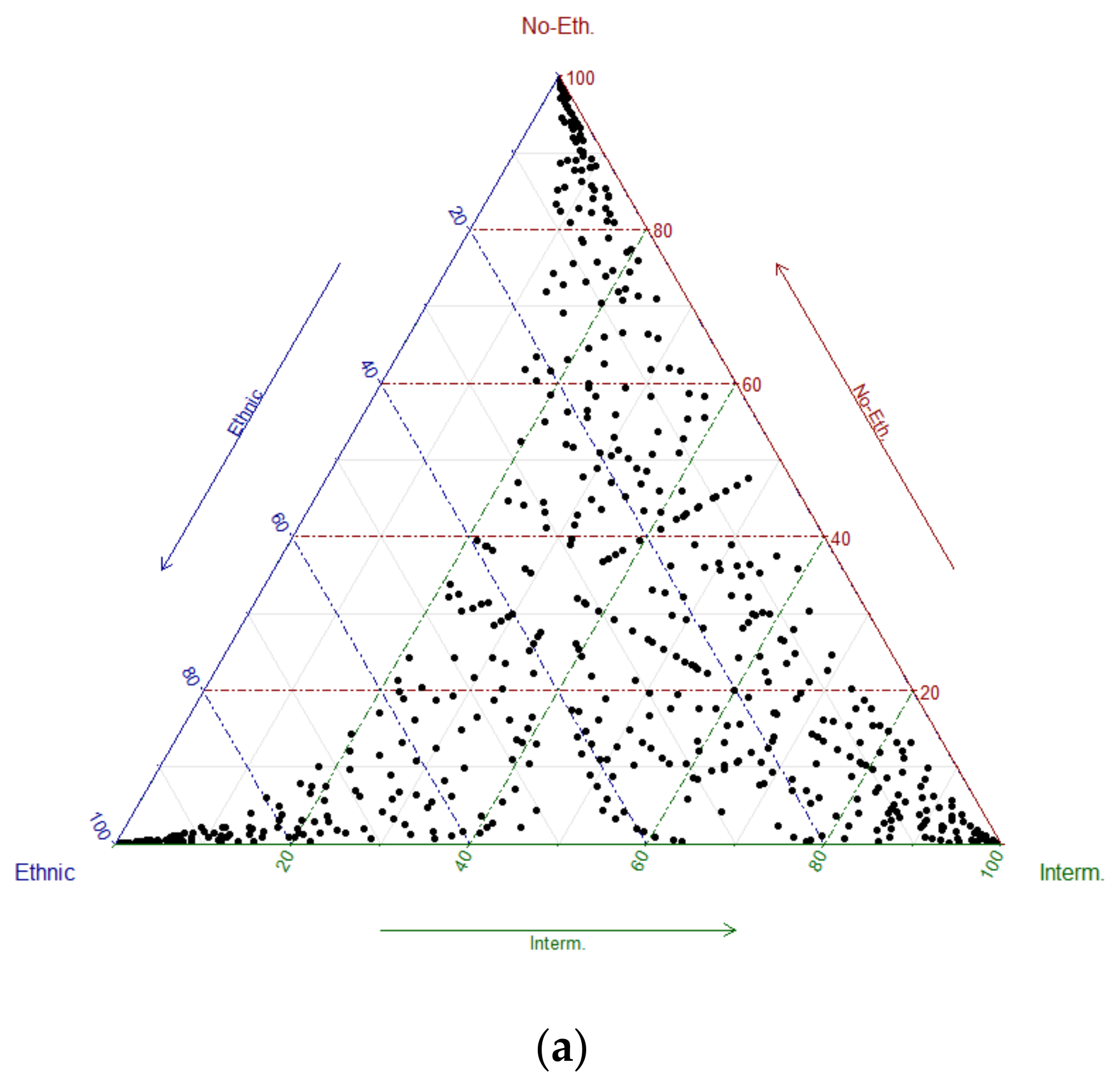
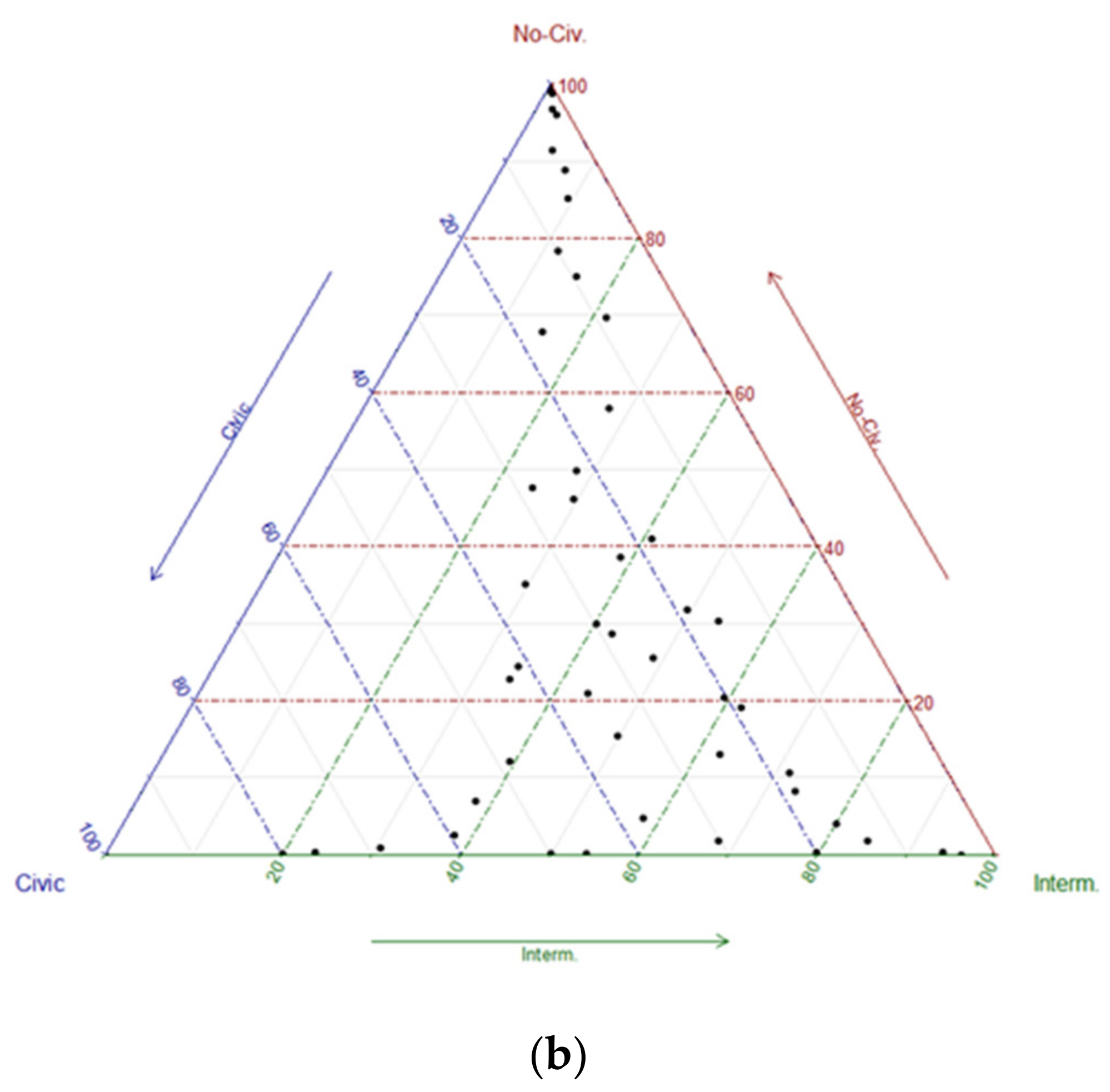
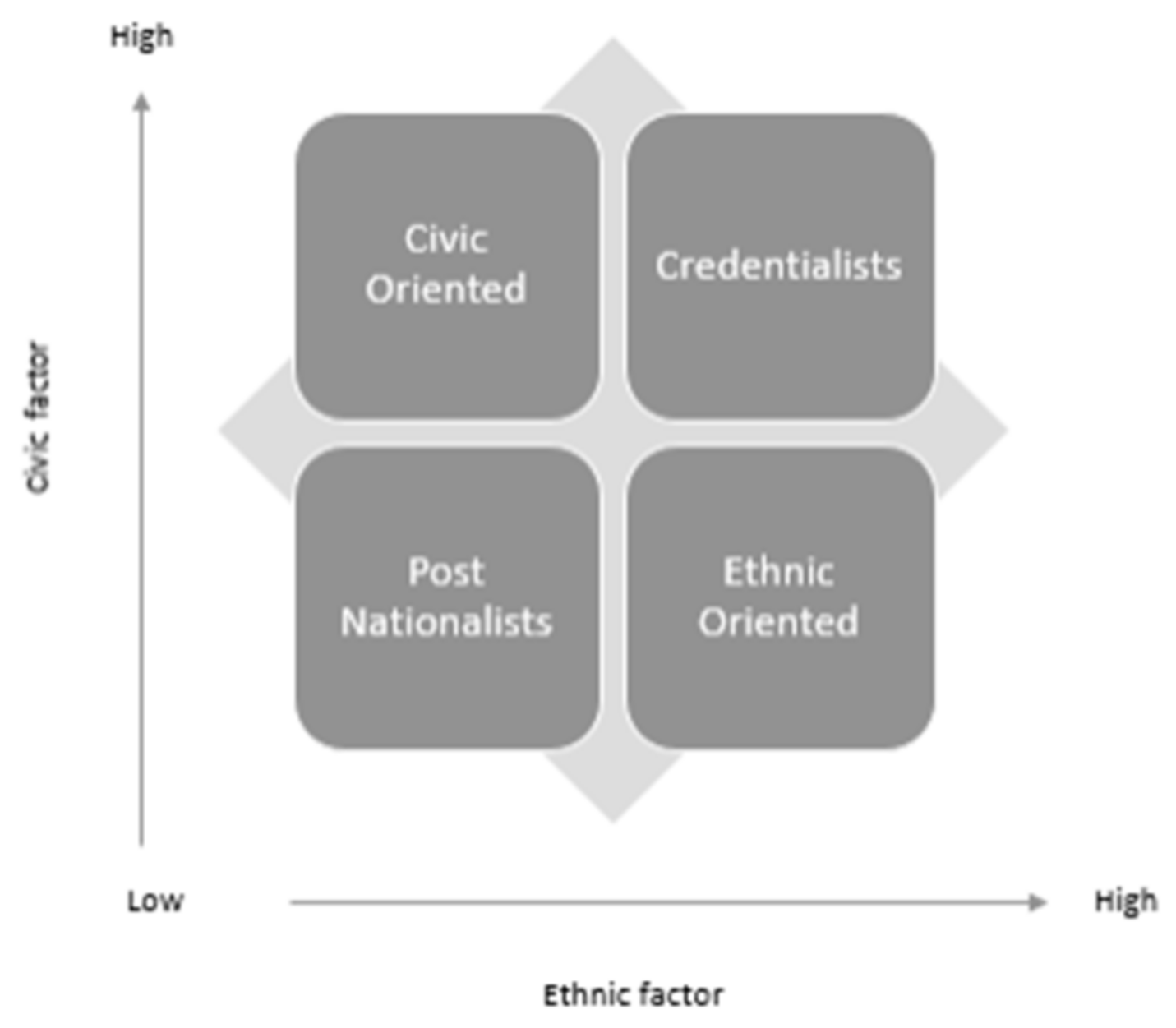
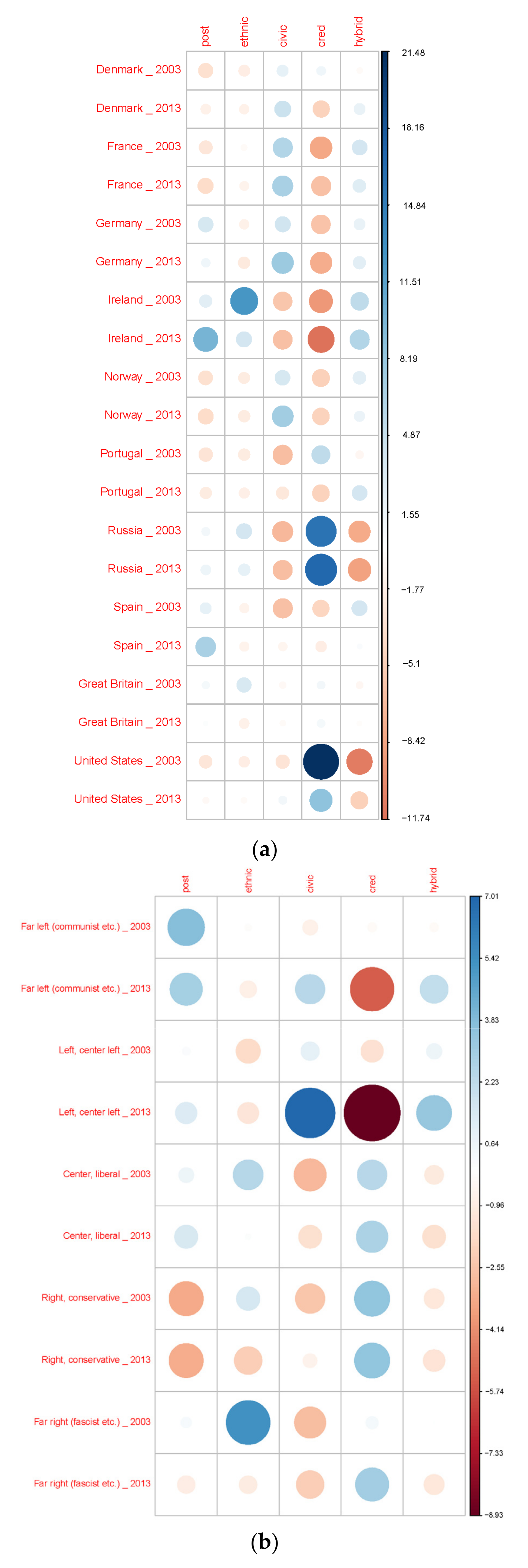
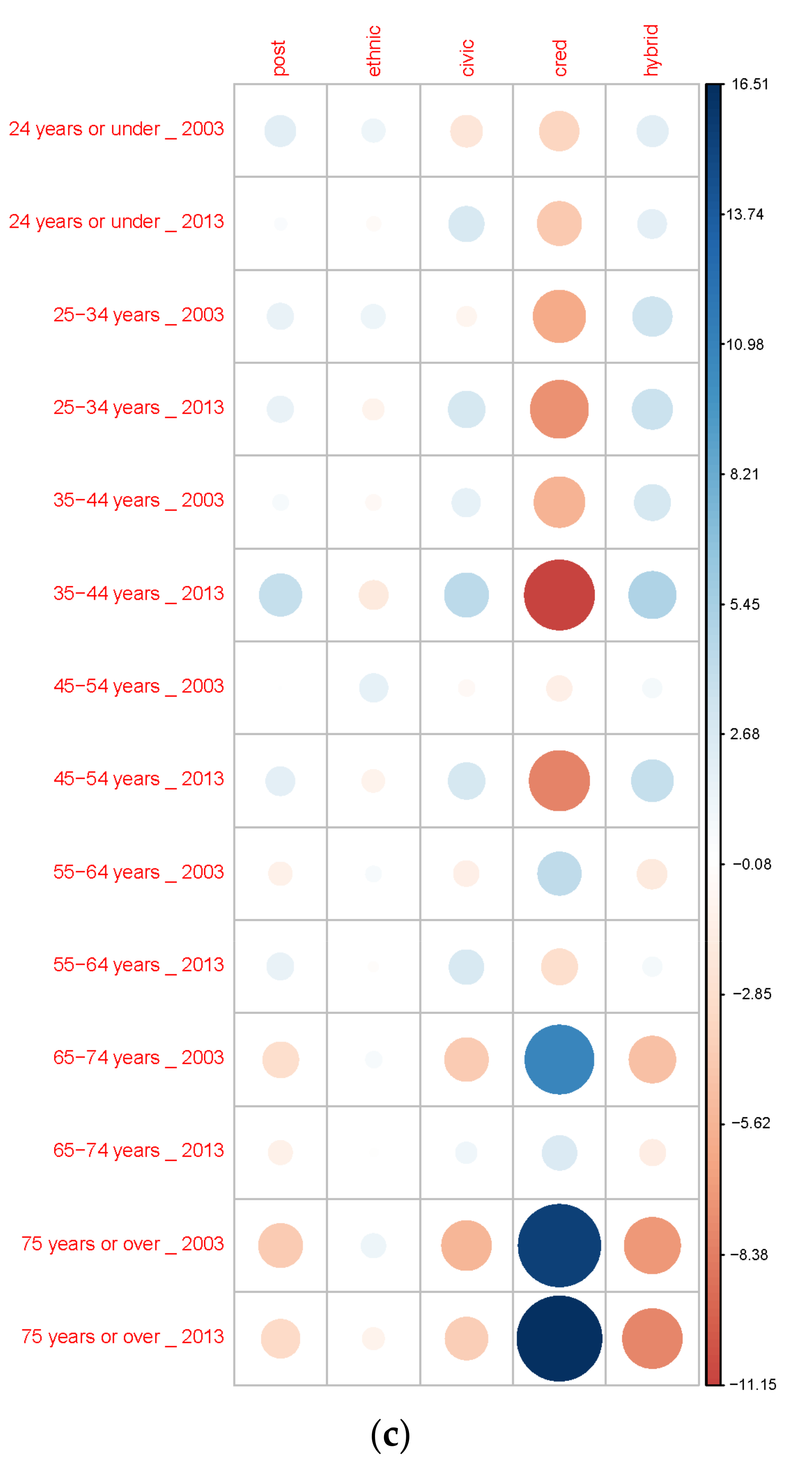
| Variable | N | % * | Variable | N | % * |
|---|---|---|---|---|---|
| Year | Gender | ||||
| 2003 | 14,096 | 50.57 | Male | 12,645 | 45.37 |
| 2013 | 13,777 | 49.43 | Female | 15,219 | 54.60 |
| Political Orientation | Age | ||||
| Far Left | 1530 | 5.49 | 24 years or under | 1151 | 4.13 |
| Left-Center | 5751 | 20.63 | 25–34 years | 3655 | 13.11 |
| Center-Liberal | 4436 | 15.92 | 35–44 years | 4773 | 17.12 |
| Right | 5849 | 20.98 | 45–54 years | 5203 | 18.67 |
| Far Right | 691 | 2.48 | 55–64 years | 4919 | 17.65 |
| 65–74 years | 4265 | 15.30 | |||
| 75 years or over | 3843 | 13.79 | |||
| Religion | Education | ||||
| No Religion | 5828 | 20.90 | No Formal education | 848 | 3.04 |
| Catholic | 9700 | 34.80 | Primary school | 1827 | 6.55 |
| Protestant | 7483 | 26.85 | Lower secondary | 7313 | 26.24 |
| Other Christians | 3540 | 12.70 | Upper secondary | 6102 | 21.89 |
| Jewish | 96 | 0.34 | Post-secondary | 4316 | 15.48 |
| Islamic | 464 | 1.66 | Lower level tertiary | 7213 | 25.88 |
| Other Religions | 308 | 1.10 |
| Criteria | Ethnic | Civic |
|---|---|---|
| To have been born in (country) | 0.85 | −0.11 |
| To have the (country) citizenship | 0.45 | 0.30 |
| To have lived in (country) for most of one’s life | 0.62 | 0.14 |
| To be able to speak the (country) language | 0.01 | 0.60 |
| To be (religion) | 0.58 | −0.05 |
| To respect the (country’s) political institutions and laws | −0.18 | 0.68 |
| To feel (country nationality) | 0.28 | 0.43 |
| To have (country nationality) ancestry | 0.84 | −0.13 |
| Cronbach’s alfa | 0.80 | 0.60 |
| Promax rotation | ||
| Model | Df | χ2 | CFI | TLI | RMSEA | SRMR |
|---|---|---|---|---|---|---|
| Unidimensional model. Group by country-year | ||||||
| Configural (pool) | 20 | 7342.2 | 0.976 | 0.967 | 0.115 | 0.071 |
| Configural (MGCFA) | 400 | 6977.6 | 0.903 | 0.865 | 0.109 | 0.049 |
| Metric | 533 | 10,934.6 | 0.847 | 0.839 | 0.118 | 0.098 |
| Scalar | 666 | 25,765.1 | 0.632 | 0.690 | 0.164 | 0.152 |
| Second order latent model (2 factors (Ethnic:Ind1-Ind3,Ind5,Ind8; Civic:Ind4,Ind6,Ind7; Nat.Id (Ethnic, Civic)Group by country-year | ||||||
| Configural (pool) | 18 | 4420.7 | 0.985 | 0.978 | 0.093 | 0.054 |
| Configural (MGCFA) | 360 | 5482.5 | 0.925 | 0.884 | 0.101 | 0.042 |
| Metric | 387 | 7716.4 | 0.894 | 0.880 | 0.102 | 0.076 |
| Scalar | 292 | 16,799.3 | 0.762 | 0.773 | 0.140 | 0.111 |
| Ethnic Identity | Most | Least | Interm. | Civic Identity | Most | Least | Interm |
|---|---|---|---|---|---|---|---|
| Nativity | 4 | 1 | 3 | ||||
| Citizenship | 4 | 1 | 4 | Language | 4 | 1 | 3 |
| Living | 4 | 1 | 4 | Respect | 4 | 1 | 4 |
| Religion | 4 | 1 | 1 | Feeling | 4 | 1 | 4 |
| Ancestry | 4 | 1 | 3 |
| Country-Year | Post Nationalists | Ethnic Oriented | Civic Oriented | Credentialists |
|---|---|---|---|---|
| Denmark 2003 | 0.261371 | 0 | 1.307533 | 1.076628 |
| Denmark 2013 | 0.651949 | 0.231167 | 1.651099 | 0.732112 |
| France 2003 | 0.448565 | 0.734084 | 1.812449 | 0.578677 |
| France 2013 | 0.314069 | 0.455573 | 1.807723 | 0.705653 |
| Germany 2003 | 1.789863 | 0.237993 | 1.594921 | 0.651695 |
| Germany 2013 | 1.240994 | 0 | 1.982003 | 0.611842 |
| Ireland 2003 | 1.622221 | 7.765269 | 0.050721 | 0.413658 |
| Ireland 2013 | 3.175681 | 3.025153 | 0.066688 | 0.306806 |
| Norway 2003 | 0.313622 | 0 | 1.507635 | 0.726669 |
| Norway 2013 | 0.254336 | 0 | 1.976663 | 0.750991 |
| Portugal 2003 | 0.395923 | 0 | 0.151924 | 1.286691 |
| Portugal 2013 | 0.46025 | 0 | 0.566617 | 0.685549 |
| Russia 2003 | 1.18416 | 2.442147 | 0.249346 | 1.667388 |
| Russia 2013 | 1.331314 | 2.023096 | 0.124875 | 1.896975 |
| Spain 2003 | 1.472982 | 0.25272 | 0.044569 | 0.726973 |
| Spain 2013 | 2.491599 | 0.250038 | 0.815774 | 0.885241 |
| Great Britain 2003 | 1.253365 | 3.157698 | 0.866259 | 1.077201 |
| Great Britain 2013 | 1.082976 | 0 | 0.896307 | 1.073062 |
| United States 2003 | 0.378874 | 0 | 0.533067 | 2.267803 |
| United States 2013 | 0.85886 | 0.721264 | 1.165997 | 1.496239 |
| Political Orientation-Year | Post Nationalists | Ethnic Oriented | Civic Oriented | Credentialists |
| Far left (communist etc.) 2003 | 1.63478 | 0.790443 | 0.940949 | 1.000247 |
| Far left (communist etc.) 2013 | 1.449256 | 0.405691 | 1.538245 | 0.611558 |
| Left. center left 2003 | 0.765906 | 0.387963 | 1.154584 | 0.96578 |
| Left. center left 2013 | 0.910583 | 0.472498 | 1.80197 | 0.653454 |
| Center. liberal 2003 | 0.836642 | 1.779932 | 0.719361 | 1.130289 |
| Center. liberal 2013 | 0.947265 | 0.904292 | 0.899911 | 1.136275 |
| Right. conservative 2003 | 0.347502 | 1.33485 | 0.823933 | 1.150243 |
| Right. conservative 2013 | 0.341595 | 0.213745 | 1.008351 | 1.152859 |
| Far right (fascist etc.) 2003 | 0.848976 | 5.268002 | 0.331802 | 1.061607 |
| Far right (fascist etc.) 2013 | 0.405555 | 0 | 0.380405 | 1.402062 |
| Age-Year | Post Nationalists | Ethnic Oriented | Civic Oriented | Credentialists |
| 24 years or under 2003 | 1.59969 | 1.791209 | 0.55281 | 0.724582 |
| 24 years or under 2013 | 1.109849 | 0.655882 | 1.677201 | 0.589596 |
| 25–34 years 2003 | 1.247616 | 1.508108 | 0.90428 | 0.71956 |
| 25–34 years 2013 | 1.2766 | 0.565819 | 1.380372 | 0.612971 |
| 35–44 years 2003 | 1.072133 | 0.814619 | 1.180092 | 0.769307 |
| 35–44 years 2013 | 1.640784 | 0.286125 | 1.48857 | 0.504523 |
| 45–54 years 2003 | 0.995897 | 1.612088 | 0.94429 | 0.944345 |
| 45–54 years 2013 | 1.268177 | 0.602235 | 1.30636 | 0.664637 |
| 55–64 years 2003 | 0.803332 | 1.201687 | 0.847702 | 1.179955 |
| 55–64 years 2013 | 1.228562 | 0.933476 | 1.275841 | 0.885933 |
| 65–74 years 2003 | 0.516492 | 1.220914 | 0.511376 | 1.496431 |
| 65–74 years 2013 | 0.790635 | 0.949547 | 1.112405 | 1.114347 |
| 75 years or over 2003 | 0.226219 | 1.546953 | 0.318285 | 1.756688 |
| 75 years or over 2013 | 0.447075 | 0.594462 | 0.537291 | 1.749079 |
Publisher’s Note: MDPI stays neutral with regard to jurisdictional claims in published maps and institutional affiliations. |
© 2022 by the authors. Licensee MDPI, Basel, Switzerland. This article is an open access article distributed under the terms and conditions of the Creative Commons Attribution (CC BY) license (https://creativecommons.org/licenses/by/4.0/).
Share and Cite
Indelicato, A.; Martín, J.C. Two Approaches to Analyze Whether Citizens’ National Identity Is Affected by Country, Age, and Political Orientation—A Fuzzy Eco-Apostle Model. Appl. Sci. 2022, 12, 3946. https://doi.org/10.3390/app12083946
Indelicato A, Martín JC. Two Approaches to Analyze Whether Citizens’ National Identity Is Affected by Country, Age, and Political Orientation—A Fuzzy Eco-Apostle Model. Applied Sciences. 2022; 12(8):3946. https://doi.org/10.3390/app12083946
Chicago/Turabian StyleIndelicato, Alessandro, and Juan Carlos Martín. 2022. "Two Approaches to Analyze Whether Citizens’ National Identity Is Affected by Country, Age, and Political Orientation—A Fuzzy Eco-Apostle Model" Applied Sciences 12, no. 8: 3946. https://doi.org/10.3390/app12083946
APA StyleIndelicato, A., & Martín, J. C. (2022). Two Approaches to Analyze Whether Citizens’ National Identity Is Affected by Country, Age, and Political Orientation—A Fuzzy Eco-Apostle Model. Applied Sciences, 12(8), 3946. https://doi.org/10.3390/app12083946







